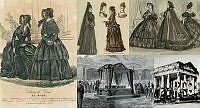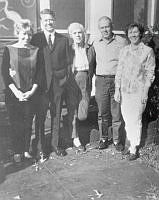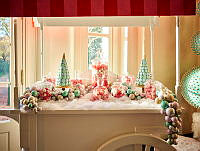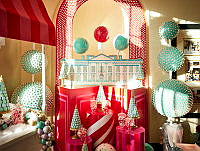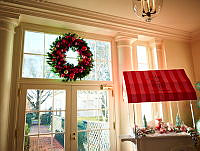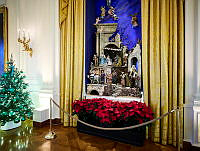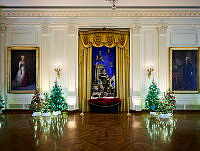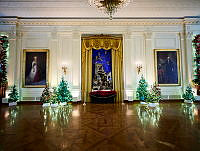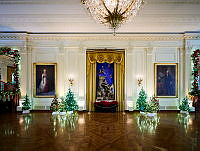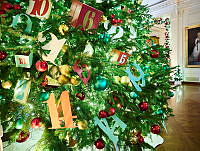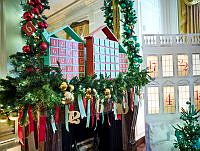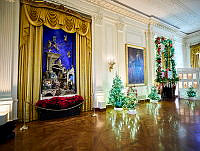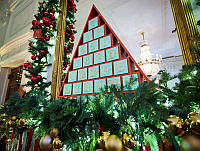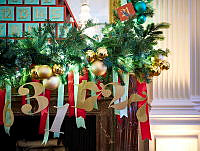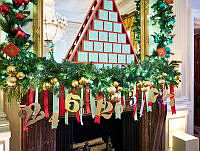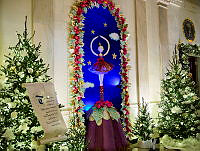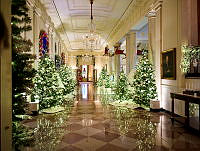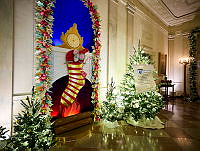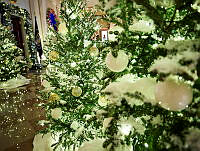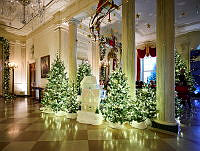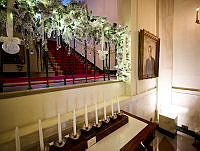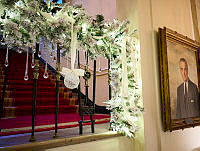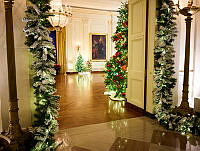The White House Collection: George Washington
Images and Influences
Copyright © Fall 1999 White House Historical Association. All rights reserved under international copyright conventions. No part of this article may be reproduced or utilized in any form or by any means, electronic or mechanical, including photocopying, recording, or by any information storage and retrieval system, without permission in writing from the publisher. Requests for reprint permissions should be addressed to books@whha.org

This handsome gilded bronze clock, made in Paris between 1806 and 1817, is the world of the skilled clockmaker Dubuc [possibly, Jean-Baptiste Dubuc], who made such clocks for the American market.
The White House“It is of very great importance to fix the taste of our Country properly, and I think your Example will go so far in that respect. It is therefore my Wish that every Thing about you should be substantially good and majestically plain; made to endure” wrote Gouverneur Morris, the American businessman and diplomat in Paris, to President George Washington in 1790.1 Morris had been asked to secure porcelain and silver for Washington’s table in the first “President’s House” in New York. In the White House China Room are examples of the porcelain dinner services owned by Washington and used by him as president, many donated by Washington family descendants. Among them are pieces from a white and gilt French porcelain service made at the Royal Porcelain Manufactory at Sevres, circa 1780, that the Washingtons used as a state service; the Society of the Cincinnati sendee, of Chinese export porcelain, commissioned for officers in the American Revolution and purchased for Washington by General Henry Lee in 1786; and the Martha Washington “states” service, also Chinese export porcelain, presented to her in 1796 by a director of the Dutch East India Company. The “states” service was decorated with a border of chain links representing the 15 states.2

Porcelain manufacturers in England, France, and Germany turnedto portraits of Washington by 18th-century American artists to reproduce ontheir wares. The image on this small cup, made by the Royal Saxon Porcelain Manufactory at Meissen, Germany, c. 1800, was derived from a painting by Charles Willson Peale.
The White House/ White House Historical AssociationRecently, the White House received a gift of a pair of Philadelphia side chairs in the Chippendale style, circa 1760-85, with a history of use by Washington in his New York and Philadelphia residences where he lived from 1789 to 1797. They may be from a group of “plain” mahogany chairs purchased in 1789 from the New York cabinetmaker and merchant Thomas Burling, who supplied much household furniture for the house on Cherry Street.3 A carved and painted French armchair in the White House, made in the Louis XVI style of the 1780s, could be one of the 12 arm chairs purchased by Washington in 1790 from the French minister, the comte de Moustier, when Washington and his family moved into a larger house formerly occupied by the French legation in New York.
When John and Abigail Adams moved into the new President’s House in Washington, D.C., in November 1800, they brought with them many items that had been purchased for Washington’s residences. These furnishings (silver, plate, furniture, lighting fixtures, textiles, and fireplace equipment) continued to be used by Thomas Jefferson and James and Dolley Madison, but were lost in the fire that consumed the contents of the White House in 1814.
Washington prepared meticulous lists distinguishing his personal property from that owned by the U.S. government when he left office in 1797. When Abigail Adams prepared to move to Washington in 1800 she wrote that much of the furniture passed down by Washington was “so worn, and defaced as to not be worth the freight” but government officials in Philadelphia “thought best to send it.”4 Margaret Bayard Smith, who chronicled social life in the new city and was a frequent guest of Jefferson, recalled that Jefferson found the President’s House “scantily furnished with articles brought from Philadelphia and which had been used by Genl. Washington,”5 but, she continued, Jefferson retained the worn and faded pieces out of respect for Washington. Lists of silver in Jefferson’s small dining room in 1809 match exactly the pieces of silver that appear on the bill of sale of goods purchased for Washington’s use in New York in 1789. One can only imagine the thoughts of Adams, Jefferson, and Madison and their guests in their encounters with objects associated with the first President.

This presentation saber was commissioned by French volunteers who fought in the American Revolution for President George Washington. The handle and scabbard of the saber consist of gilded brass.
The White House Historical AssociationGeorge Washington never lived in the White House, but portraits of him and objects with his likeness are abundant in the mansion. The first president was revered during his lifetime, and after his death in 1799 a wide variety of commemorative objects were made with his likeness—symbols not only of the man esteemed by his fellow citizens, but of the new nation.
More portraits of Washington—on canvas, ivory miniatures, silhouettes, prints, and marble and bronze sculpture— are represented in the White House than of any other president. Renowned late-18th- and early-19th-century artists such as Gilbert Stuart (1755-1828), Charles Willson Peale (1741-1827), and his son, Rembrandt Peale (1778-1860) painted portraits from life, and many unknown artists and artisans produced images through out the 19th century. Washington’s portrait or iconic references to him appear, too, on textiles such as counterpanes, printed cotton toile, and mourn ing samplers in needlework made after his death. Porcelain manufacturers in China, Germany, and France produced his likeness on cups, plates, and vases and imported them to America. French clockmakers incorporated his figure, and an American manufacturer included bust portraits of him on lighting fixtures. In the late 18th century, the French volunteers in the American Revolution commissioned a special gilded brass and steel saber from the Klingenthal armory in Alsace as a gift to Washington. It was not finished before Washington’s death, but in 1933 the French government presented it to President Franklin D. Roosevelt as a token of the friendship between France and America, and it resides in the White House Library today.

Detail from the hilt of a gilded brass saber commissionedby the French volunteers in the American Revolution for presentationto George Washington.
The White House Historical AssociationThe symbolism of Washington, so strong in the early republic, continues to be reflected in the 22 works of art, 49 prints, and 27 objects in the White House that serve to remind its occupants and other Americans of Gouveneur Morris’s hope that objects associated with Washington be “made to endure.” The survival of these objects, some made more than 200 years ago, speaks to the admiration and high regard Americans felt toward the first president of the United States.













